A novel surface protein of Trichomonas vaginalis is regulated independently by low iron and contact with vaginal epithelial cells
- PMID: 16448556
- PMCID: PMC1403785
- DOI: 10.1186/1471-2180-6-6
A novel surface protein of Trichomonas vaginalis is regulated independently by low iron and contact with vaginal epithelial cells
Abstract
Background: Trichomonosis caused by Trichomonas vaginalis is the number one, non-viral sexually transmitted disease (STD) that affects more than 250 million people worldwide. Immunoglobulin A (IgA) has been implicated in resistance to mucosal infections by pathogens. No reports are available of IgA-reactive proteins and the role, if any, of this class of antibody in the control of this STD. The availability of an IgA monoclonal antibody (mAb) immunoreactive to trichomonads by whole cell (WC)-ELISA prompted us to characterize the IgA-reactive protein of T. vaginalis.
Results: An IgA mAb called 6B8 was isolated from a library of mAbs reactive to surface proteins of T. vaginalis. The 6B8 mAb recognized a 44-kDa protein (TV44) by immunoblot analysis, and a full-length cDNA clone encoded a protein of 438 amino acids. Southern analysis revealed the gene (tv44) of T. vaginalis to be single copy. The tv44 gene was down-regulated at both the transcriptional and translational levels in iron-depleted trichomonads as well as in parasites after contact with immortalized MS-74 vaginal epithelial cells (VECs). Immunofluorescence on non-permeabilized organisms confirmed surface localization of TV44, and the intensity of fluorescence was reduced after parasite adherence to VECs. Lastly, an identical protein and gene were present in Tritrichomonas foetus and Trichomonas tenax.
Conclusion: This is the first report of a T. vaginalis gene (tv44) encoding a surface protein (TV44) reactive with an IgA mAb, and both gene and protein were conserved in human and bovine trichomonads. Further, TV44 is independently down-regulated in expression and surface placement by iron and contact with VECs. TV44 is another member of T. vaginalis genes that are regulated by at least two independent signaling mechanisms involving iron and contact with VECs.
Figures
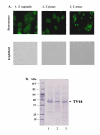
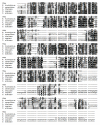
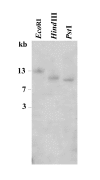

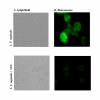
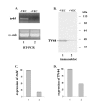
Similar articles
-
Adherence to human vaginal epithelial cells signals for increased expression of Trichomonas vaginalis genes.Infect Immun. 2005 Oct;73(10):6472-8. doi: 10.1128/IAI.73.10.6472-6478.2005. Infect Immun. 2005. PMID: 16177319 Free PMC article.
-
Heterologous expression in Tritrichomonas foetus of functional Trichomonas vaginalis AP65 adhesin.BMC Mol Biol. 2005 Mar 4;6:5. doi: 10.1186/1471-2199-6-5. BMC Mol Biol. 2005. PMID: 15748280 Free PMC article.
-
Iron and contact with host cells induce expression of adhesins on surface of Trichomonas vaginalis.Mol Microbiol. 2003 Mar;47(5):1207-24. doi: 10.1046/j.1365-2958.2003.03366.x. Mol Microbiol. 2003. PMID: 12603729 Free PMC article.
-
Trichomonas vaginalis surface proteins: a view from the genome.Trends Parasitol. 2007 Nov;23(11):540-7. doi: 10.1016/j.pt.2007.08.020. Epub 2007 Oct 24. Trends Parasitol. 2007. PMID: 17962075 Review.
-
Trichomonas vaginalis pathobiology new insights from the genome sequence.Adv Parasitol. 2011;77:87-140. doi: 10.1016/B978-0-12-391429-3.00006-X. Adv Parasitol. 2011. PMID: 22137583 Review.
Cited by
-
Effect of Nigella sativa alcoholic extract and oil, as well as Phaseolus vulgaris (kidney bean) lectin on the ultrastructure of Trichomonas vaginalis trophozoites.J Parasit Dis. 2016 Sep;40(3):707-13. doi: 10.1007/s12639-014-0564-x. Epub 2014 Sep 11. J Parasit Dis. 2016. PMID: 27605771 Free PMC article.
-
In-Vitro Effect of Kalanchoe daigremontiana and Its Main Component, Quercetin against Entamoeba histolytica and Trichomonas vaginalis.Iran J Parasitol. 2021 Jul-Sep;16(3):394-401. doi: 10.18502/ijpa.v16i3.7092. Iran J Parasitol. 2021. PMID: 34630584 Free PMC article.
-
Phosphoglycerate kinase: structural aspects and functions, with special emphasis on the enzyme from Kinetoplastea.Open Biol. 2020 Nov;10(11):200302. doi: 10.1098/rsob.200302. Epub 2020 Nov 25. Open Biol. 2020. PMID: 33234025 Free PMC article. Review.
-
Identification and molecular characterization of numerous Histomonas meleagridis proteins using a cDNA library.Parasitology. 2009 Apr;136(4):379-91. doi: 10.1017/S0031182008005477. Epub 2009 Jan 21. Parasitology. 2009. PMID: 19154645 Free PMC article.
-
Transcriptomic identification of iron-regulated and iron-independent gene copies within the heavily duplicated Trichomonas vaginalis genome.Genome Biol Evol. 2012;4(10):1017-29. doi: 10.1093/gbe/evs078. Epub 2012 Sep 12. Genome Biol Evol. 2012. PMID: 22975721 Free PMC article.
References
-
- Cates W., Jr Estimates of the incidence and prevalence of sexually transmitted diseases in the United States. American Social Health Association Panel. Sex Transm Dis. 1999;26:S2–7. - PubMed
-
- World Health Organization: three hundred, thirty-three million new, STD curable cases in 1995. AIDS Wkly. 1995. pp. 15–16. - PubMed
-
- Cotch MF, Pastorek JG, 2nd, Nugent RP, Hillier SL, Gibbs RS, Martin DH, Eschenbach DA, Edelman R, Carey JC, Regan JA. Trichomonas vaginalis associated with low birth weight and preterm delivery. The Vaginal Infections and Prematurity Study Group. Sex Transm Dis. 1997;24:353–360. - PubMed
Publication types
MeSH terms
Substances
Grants and funding
LinkOut - more resources
Full Text Sources
Medical
Research Materials
Miscellaneous

